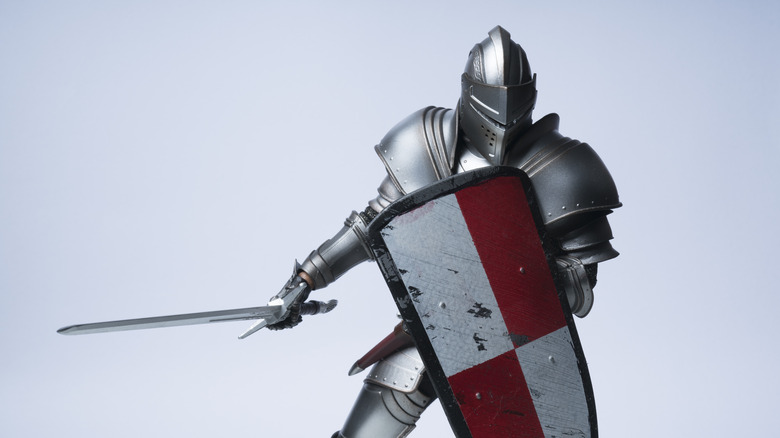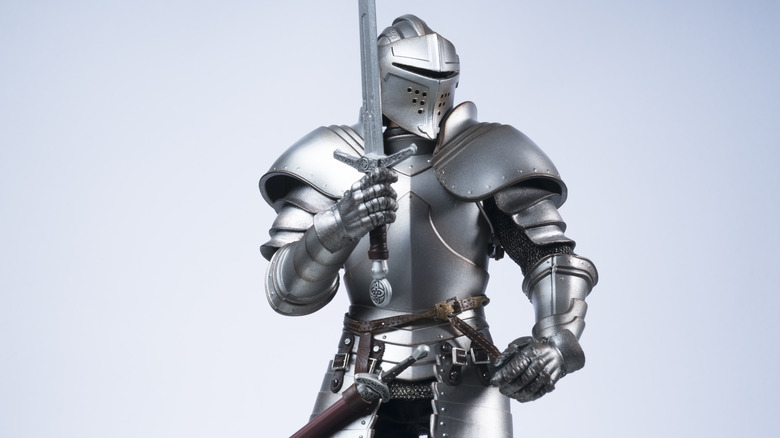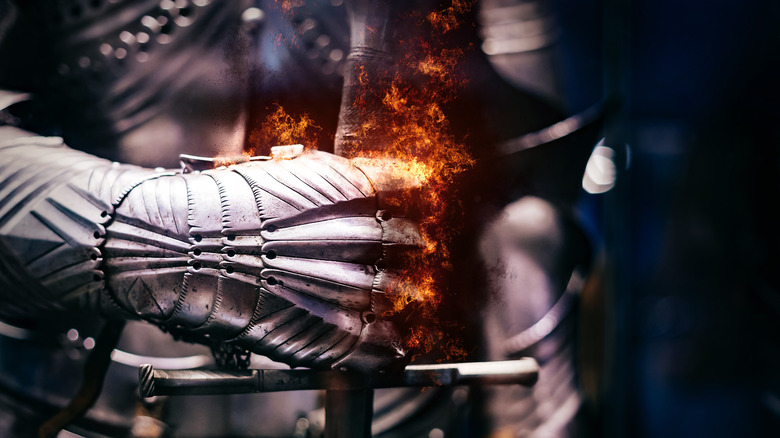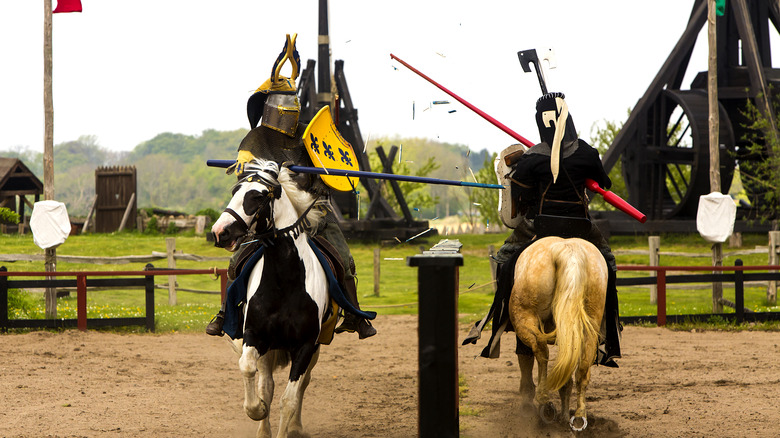These Were The Perks Of Being A Medieval Knight
Ah, to be a medieval knight. Seems rather thrilling — with all the swordplay, roundtable shenanigans, and castles. Knights received status, wealth, and other advantages from the job. Still, the process of becoming a knight proved arduous. The journey started as young as 7, with horse and weapon training. A youngster would work with a local knight, baron, or royal court member to learn the skills they needed on the battlefield. After years of study, and serving various masters, knighthood was dubbed around the age of 18 to 21, if the individual made it that far. Many pages and squires never advanced to the next level (via World History Encyclopedia).
Most of the time, knight status could only be achieved by the wealthy, said Medieval Life. Occasionally, a lower-class member performed a brave act and received a knighthood for their valor. While some females belonged to chivalric orders, they weren't technically knights — although many proved potent during warfare, including Nicholaa de la Haye, born around 1150, who successfully defended her castle for 40 days (from ThoughtCo). Early knights often behaved like thugs. "In the early Middle Ages, church councils were praying to be delivered from knights," said Jennifer Goodman Wollock, professor of medieval studies at Texas A&M, to History. "What develops as you get into the late 11th, 12th century is a sense that knights have to have a professional code if they're going to be respected and respectable."
With better behavior came rewards ... and, sometimes, the knights received riches.
A profession that could bring riches
While the knighthood could offer danger, it also created opportunities. A knight favored by a king or lord for his military service might receive a fief — a section of the king's land gifted to the knight, according to How Stuff Works. Often, the deal came with peasants who worked the land for him. Basically, the knight paid no rent and had underlings who did all the farming and maintenance for free. As long as the knight held the noble's esteem, the land remained his. Plus, the knight's children could inherit his fiefdom, if the beneficiary also continued serving his king.
Knights also aspired to marry well, hoping that their status provided access to an heiress. Such unions increased their wealth and landholdings, said About Britain. Most knights only achieved this, though, if favored by their lord, explained Find Any Answer. Then, arrangements for a wedding between the knight and one of the manor's daughters might occur — an event that cemented the knight's relationship with his benefactor.
When not at war, peacetime knights only worked 40 days a year, according to Britannica. Their duties lightened as well and instead of charging on the battlefield, knights mostly protected those that employed them. In England, knights only served the king but in other places, such as France, other noble factions could call them to duty. This made them powerful; who is going to say no to a knight collecting taxes? As time passed, though, the knighthood changed.
The end of the knighthood
Knights sometimes were called to war in the name of God. The eight Crusades a series of Christian-Muslim religious wars fought between 1095 and 1291 to secure holy sites and extend land holdings is an example of this, according to World History. Sometimes ransacking the stricken areas provided bounty for the knights. Richard Kaeuper, a historian at the University of Rochester, said to History, that despite the knights' attempts to stay honorable and pious, they often failed to listen to religious leaders' dictates: Like that time during the Fourth Crusade when they pillaged Constantinople instead of overthrowing the Muslim rulers of Jerusalem as Pope Innocent III had commanded.
While these battles enabled several orders, such as the Knights Templar, the Teutonic Knights, and the Hospitallers, to rise to prominence as they protected the Holy Land and traveling pilgrims, by 1291 enthusiasm for the endeavor diminished, said another History story. As armies professionalized, the need for knights waned. New powerful weapons like the crossbow and firearms easily killed knights on horseback despite their rigorous years of training, according to War History Online. The final years of the Middle Ages also saw the last time knights offered their powerful presence on the battlefield as they became replaced with paid soldiers and mercenaries (from Ducksters).
Knighthood today exists, but it is transformed from Medieval days.
New knights but different perks
Modern-day knighthood looks much different from the past. Usually, it is something bestowed upon a person by royalty for a service, although not necessarily a military one. The Queen of England, for example, has made musicians Paul McCartney, Elton John, and Bono honorary knights for their cultural contribution to society. Elements of the knighthood also appear in martial arts, with schools in North American and Europe teaching similar methodology and using medieval fighting techniques in their curricula. Such educational places will offer students knighthood after several courses of instruction and testing. You can often see these "knights," garbed in armor fighting at demonstrations or Medieval and Renaissance fairs (via How Stuff Works).
Some medieval knight orders remain, like the Knights Hospitallers and Teutonic Knights. Rather than fighting battles, these "knights" have other missions. Knights Hospitaller became the Order of Saint John, and now conducts charitable missions around the globe, according to Malta Uncovered. The Teutonic Knights have also gone humanitarian as and are headquartered in Vienna (as per Encyclopedia.com). Guess the perks of knighthood these days are more about feeling good about the work you do than collecting riches.



